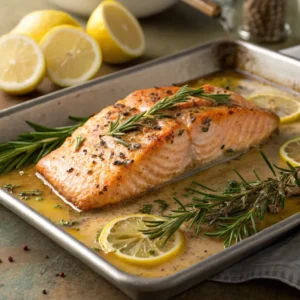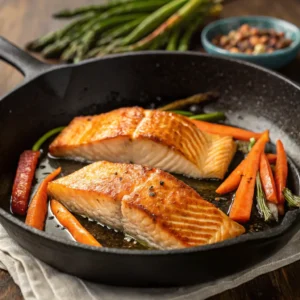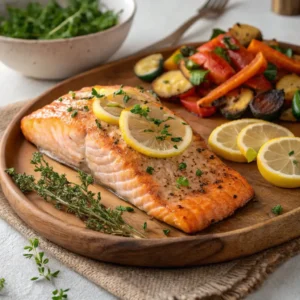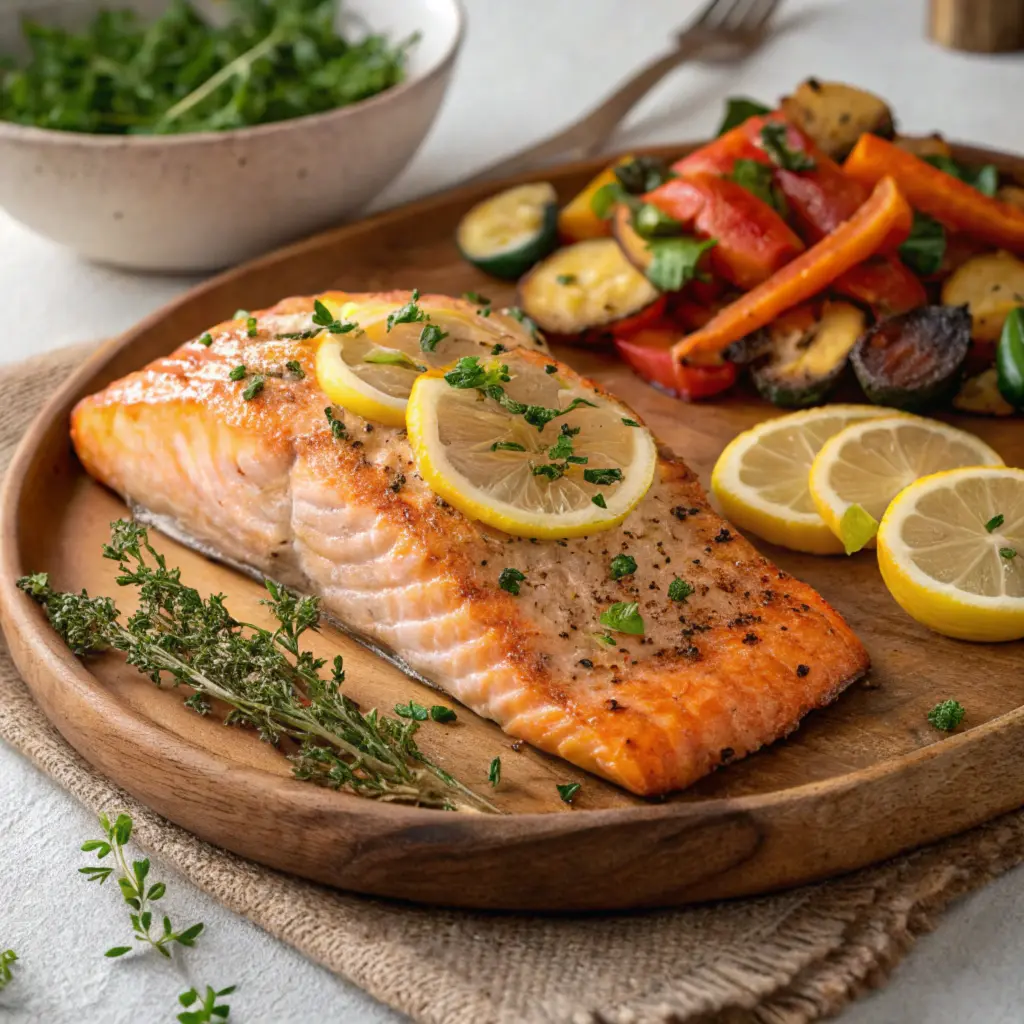Introduction
King Salmon, also known as Chinook salmon, is one of the most prized fish in the culinary world. Known for its rich, buttery texture and delicate flavor, king salmon is a versatile ingredient that can be prepared in a variety of ways. It’s a fish that’s not only delicious but also incredibly nutritious. Packed with Omega-3 fatty acids, high-quality protein, and essential vitamins, king salmon is an excellent addition to any diet. However, to truly appreciate the richness of this fish, it’s essential to master the cooking techniques that will bring out its best qualities.

Table of Contents
Understanding King Salmon
What Is King Salmon?
King Salmon is the largest and fattiest species of salmon, often weighing over 50 pounds. It is highly regarded for its tender, flavorful meat and high oil content, which gives it a rich, melt-in-your-mouth texture. This fish is found in the cold, clean waters of the North Pacific Ocean and is a highly sought-after delicacy. Whether fresh or frozen, king salmon offers unmatched flavor, making it the top choice for those looking for a premium seafood experience.
How King Salmon Differs from Other Salmon
While all types of salmon share some common characteristics, king salmon stands out due to its superior size and fat content. Other salmon varieties, such as sockeye or coho, are leaner and have a firmer texture, while it is prized for its buttery richness. The flesh of king salmon ranges from deep red to pale pink, and its high-fat content makes it ideal for grilling, roasting, and pan-searing. Its larger size also provides versatility, with options for steaks, fillets, and even whole fish preparations.
Sustainability in King Salmon Recipes
Why Sustainability Matters
The choices we make when purchasing seafood have a profound impact on the environment, local economies, and the future availability of premium ingredients like king salmon. With global demand for seafood rising, overfishing and irresponsible aquaculture practices have threatened the delicate balance of marine ecosystems. This makes it crucial for anyone preparing this recipe to prioritize sustainable sourcing. By understanding where your fish comes from and supporting responsible fishing practices, you can enjoy this culinary treasure while promoting ecological balance.
Choosing Wild-Caught King Salmon
One of the most important aspects of sustainability is opting for wild-caught king salmon. Wild salmon typically comes from well-managed fisheries in Alaska and the Pacific Northwest, where stringent guidelines ensure that fish populations remain healthy and ecosystems are preserved. Organizations such as the Marine Stewardship Council (MSC) and the Monterey Bay Aquarium’s Seafood Watch program provide valuable resources to help consumers identify sustainable seafood options. Look for labels or certifications that indicate the fish was responsibly harvested. Choosing sustainably caught king salmon ensures that you’re not contributing to practices that endanger fish populations or harm habitats.
The Role of Local Fisheries
Sustainability also encompasses ethical and social dimensions. Supporting local fisheries and small-scale fishers who practice responsible fishing methods not only helps protect the environment but also sustains coastal communities. These fisheries often prioritize quality over quantity, ensuring that the salmon you purchase is fresh, flavorful, and handled with care. By buying locally sourced salmon, you reduce the environmental impact of transportation, which contributes to a lower carbon footprint.
Farmed Salmon: A Responsible Choice?
Farmed salmon, particularly those labeled as “Atlantic salmon,” is another option available to consumers. However, not all farmed salmon is created equal. Some aquaculture operations use unsustainable practices, such as overcrowding, excessive antibiotic use, and feeding fish diets that disrupt ecosystems. If you choose farmed salmon, look for options that are certified by organizations like the Aquaculture Stewardship Council (ASC) or Global Aquaculture Alliance (GAA). These certifications indicate that the farming practices meet high standards for environmental responsibility, fish welfare, and social accountability.
Reducing Food Waste in King Salmon Recipes
Integrating sustainable practices into your preparation of king salmon recipes can also inspire creativity. For instance, using every part of the fish—including the bones and skin—reduces food waste. Salmon bones can be used to create rich, flavorful stocks for soups or sauces, while crispy skin can be repurposed as a garnish or a standalone snack. These small adjustments not only enhance your dishes but also reflect a deeper respect for the ingredients.
Educating and Inspiring Others
Educating yourself and others about the importance of sustainability is another way to make an impact. Sharing knowledge about responsible seafood choices can encourage others to adopt similar practices, amplifying the positive effects on the environment and industry. Whether you’re hosting a dinner party or discussing your recipe with friends, highlighting the importance of sustainability can spark meaningful conversations about how our choices as consumers shape the world.
Preparation Tips for King Salmon
Choosing the Right Cut
When preparing king salmon recipes, it’s essential to choose the right cut based on your preferred cooking method. Fillets are ideal for grilling or pan-searing, while steaks are perfect for broiling or roasting. Whole fish, although less common, can be a great option for grilling or baking. Fresh cuts will yield the best flavor, but frozen salmon is a good alternative if fresh fish is not available. Always ensure that the fish is stored properly to maintain its quality.
Essential Tools for Cooking
To get the most out of your king salmon recipes, it’s important to have the right cooking tools. A cast iron pan is great for achieving a crispy skin when pan-searing, while a grill provides a smoky flavor perfect for outdoor cooking. Baking trays and fish spatulas are also essential for roasting or baking the fish without causing it to break apart. Having these tools on hand will make cooking king salmon easier and more enjoyable.
Prepping the Fish
Before cooking, consider whether you want to keep the skin on or remove it. Skin-on preparations provide extra flavor and help retain moisture during cooking. If you prefer skinless fish, it’s easier to remove the skin after cooking. Marinating the salmon beforehand can also enhance its flavor. Simple ingredients like olive oil, lemon, garlic, and fresh herbs make excellent marinades that complement the natural taste of king salmon.
Top 5 King Salmon Cooking Methods

1. Grilling
Grilling is one of the best ways to prepare king salmon. The smoky flavor and crispy edges complement the rich flesh perfectly. For the best results, preheat your grill to medium-high heat. Place the salmon skin-side down on the grill and cook for 4-6 minutes per side, depending on the thickness of the fillet. You can use marinades like lemon herb or Meyer lemon relish for added zest and freshness. Grilled king salmon is best served with a side of roasted vegetables or a light salad.
2. Pan-Searing for Crispy Skin
Pan-searing king salmon with its skin on creates a crispy, golden crust while keeping the flesh moist and tender. Start by heating a cast iron pan with oil over medium-high heat. Season the fish with salt and pepper, then place it skin-side down in the pan. Cook for 4-5 minutes before flipping to finish cooking on the other side. This method pairs wonderfully with roasted vegetables or quinoa for a healthy, balanced meal.
3. Baking/Roasting
Baking or roasting king salmon is another excellent cooking method. For low and slow roasting, preheat your oven to 275°F and bake the salmon for 25-30 minutes. This method preserves the fish’s moisture and tenderness. For high-heat roasting, set your oven to 400°F and cook the fish for 12-15 minutes. Roasting with butter and fresh herbs enhances the flavor and makes for an elegant presentation.
4. Poaching
Poaching is a gentle cooking technique that keeps the salmon moist and flavorful. To poach king salmon, simmer it in a flavorful liquid like vegetable broth, white wine, or a mixture of both. Poaching time can vary, but generally, it takes 10-12 minutes. This method works well with light sauces or a citrus glaze.
5. Smoking
Smoking king salmon adds a unique, smoky flavor to the fish. Cold smoking preserves the salmon and gives it a delicate texture, while hot smoking cooks it at a higher temperature. Both methods require specialized equipment, but the results are worth the effort. Smoking enhances the natural richness of the fish, making it perfect for special occasions or adding to salads, spreads, or sandwiches.
Signature Recipes
Honey Brown Sugar Glazed Salmon
A simple yet indulgent recipe, honey brown sugar glazed salmon creates a sweet and savory flavor combination that complements the richness of the fish. To prepare, mix honey, brown sugar, soy sauce, and a touch of Dijon mustard. Brush the glaze over the salmon fillets and bake or broil until golden and caramelized. For substitutions, you can use maple syrup or coconut sugar for a different twist.
Lemon Garlic Butter Pan-Fried King Salmon
This quick and flavorful recipe involves pan-frying king salmon with a buttery lemon garlic sauce. To make the sauce, melt butter in a pan and add minced garlic, lemon juice, and zest. Cook the salmon in the sauce until crispy on the outside and tender on the inside. This dish pairs perfectly with roasted vegetables or mashed potatoes.
Grilled King Salmon with Meyer Lemon Relish
For a fresh and gourmet twist on king salmon recipes, try grilling the fish and topping it with a Meyer lemon relish. The sweetness of Meyer lemons, combined with fresh herbs and a bit of olive oil, complements the smoky grilled flavor of the salmon. This dish is best served with a light salad or a grain-based side like quinoa.
Roasted King Salmon in Butter
For an easy yet rich preparation, roast your king salmon in butter. Simply place the salmon on a baking sheet, drizzle with melted butter, and roast at 400°F until it’s cooked through. This method enhances the natural flavors of the fish and results in a moist, flavorful meal perfect for special occasions.

Savory Whipped Cream Topped Salmon
For an innovative approach, try topping your salmon with whipped cream. The cream balances the rich, smoky flavor of the fish, creating a unique and delicious combination. This preparation is perfect for adventurous eaters looking to experiment with bold flavors.
Serving Suggestions and Side Dishes
When serving king salmon, consider pairing it with wines like Sauvignon Blanc or Pinot Noir, both of which complement the fish’s richness. You can also serve salmon alongside fresh salads, roasted vegetables, or grains like quinoa and farro. Seasonal vegetables, such as asparagus or Brussels sprouts, are also excellent choices for pairing with salmon.
FAQs About King Salmon Recipes
1. What’s the best seasoning for king salmon?
Simple seasonings like lemon, garlic, and herbs like dill or thyme work best to highlight the natural flavors of the fish.
2. How do I prevent salmon from drying out?
To prevent drying out, avoid overcooking and consider cooking methods like poaching or baking at low temperatures.
3. Can you eat king salmon skin?
Yes, the skin of king salmon is edible and adds a crispy texture when cooked properly.
4. How do I know when salmon is fully cooked?
The fish should be opaque and flake easily with a fork when it’s done.
5. What’s the healthiest way to cook salmon?
Poaching or grilling without excessive fats are the healthiest methods for preparing this recipe.
Conclusion
Mastering the art of cooking king salmon elevates any meal with its rich flavor and versatility. By understanding the best cooking methods, using sustainable practices, and incorporating creative recipes, you can enjoy this premium fish in various ways. Don’t be afraid to experiment with different seasonings and preparations, as king salmon deserves a place in your kitchen for its exceptional taste and nutritional benefits.

